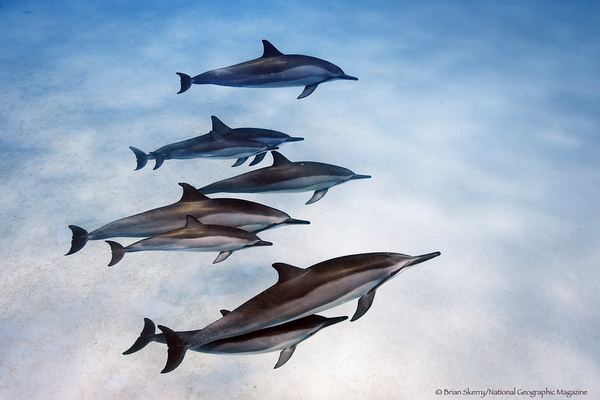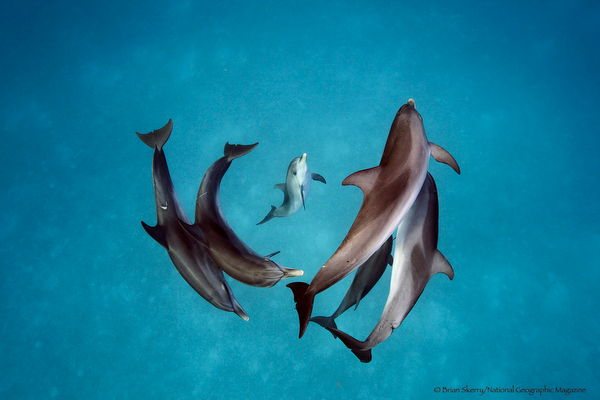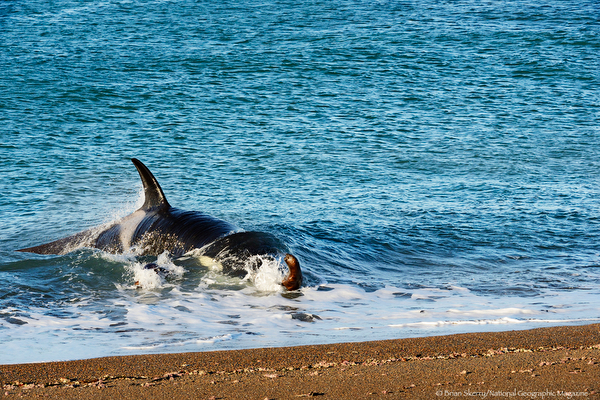Interview: Brian Skerry on photographing dolphins

Wetpixel featured a gallery of images from photographer Brian Skerry’s article in the May issue of National Geographic Magazine. Brian’s images grace the first of a three part series about dolphins, the first time the magazine has featured the animals since 1992. Wetpixel was able to catch Brian during one of his brief periods when he has internet access and ask him a few questions about the article, shooting for National Geographic and dolphins….
Wetpixel: Congratulations on the new featured articles in National Geographic magazine. For those that haven’t seen the magazine yet, the article in the May issue is part one of a three part series on dolphins. It is about dolphin intelligence and the first question has to be, how do you attempt to show intelligence in still images?
Thanks! One of the researchers with whom I worked on this story, told me that folks are always asking him “How smart are dolphins”’ But he prefers the question, “How are dolphins smart?” So this was how I approached my photo coverage for this story. I was on a quest to make pictures that showed some of the ways that demonstrate cognition or intelligence. This included things like social alliances, game play and unique feeding strategies that dolphins have created for the geographical location in which they live.
Wetpixel: What are the next two parts about?
One of the stories is about orcas feeding in Norway and was done by my colleague Paul Nicklin. The third story is about orca and dolphin re-wilding. I spent several weeks in South Korea last year photographing Indo-Pacific dolphins that had been captured illegally and kept in captivity in a zoo in Seoul. The dolphins were rehabilitated then released off Jeju Island the year before I arrived. They returned to their birth pod and are doing well. I spent weeks trying to find them in the wild and make pictures that showed them interacting with other wild dolphins. For dolphins that can be rehabilitated and released back into the wild, this is a great model.

Wetpixel: Were there any specific challenges about shooting the images for these two articles as well?
There were a number of challenges. Making still photos of mud-ring feeding in Florida hadn’t ever been done before. So we had to come up with a way I could shoot from 600+ foot altitude with a 500mm lens to show this beautiful behaviour. In Patagonia it was especially difficult to make images showing dusky dolphins cooperatively feeding on anchovies. Between bad weather, murky underwater conditions and elusive behaviour I spent three weeks with zero luck. I finally made the frame we published in the last 10 minutes of daylight on my very last day in the field. It seemed like on this story, every one of my nine location presented unique challenges, but in the end I was able to get what I needed. For the re-wilding story it was extremely difficult to get anywhere near the re-wilded animals. They wanted nothing to do with humans … which makes perfect sense.
Wetpixel: Why have you and NG decided to feature dolphins?
I had long been interested in producing a dolphin story and wanted it to show some things rarely seen by readers. The last story the magazine did on dolphins was in 1992, and the editors agreed that it was time for a new feature on these animals. The concept of focusing on cognition seemed a perfect way to look at the subject.
Wetpixel: With dolphins, there is a great deal of imagery around. How did you set out to create original pictures?
It was really began with a desire to produce a combination of beautiful images along with photos that revealed a glimpse of their lives in order to tell the story journalistically. I wanted to make images that would compel readers to want to know more. I started with a “wish list” of pictures that I believed would achieve this goal and with each location started to put the pieces together. A photo of spotted dolphins in a ballet-like moment, spinner dolphins covered in leaves, playing the “Leaf Game,” a bottlenose dolphin crater feeding. I think it was a rather ambitious shot list, but in the end it all came together nicely.

Wetpixel: Is this an idea that you had and pitched for, or did the idea originate at NG?
This was my idea. I’m currently working on my 24th story for NGM and 20 have been my proposals. Nearly every story I do for NGM is my idea, though I frequently discuss ideas with my editor Kathy Moran before writing a proposal.
Wetpixel: How long was the assignment? How long were you away from home for?
I had about 16 weeks to shoot the story, but did this over a period of about 18 months. I’ve been working for NGM for over 17 years now and I typically spend about 8 months in the field each year working on multiple stories simultaneously.
Wetpixel: How many images did you shoot in total? How many were selected for the articles?
For the dolphin cover story I probably shot 60-70,000 frames. I believe 11 images were published in the print edition.
Wetpixel: How many countries did you visit to get the images?
I worked in 9 locations for this story, which included 4 countries. For the re-wilding story I was in a 5th country, but that was a separate story.

Wetpixel: Where is the best place to see and photograph dolphins?
Many locations have great dolphin potential, though permits are often required. I think that The Bahamas is certainly one of the most predictable places and has been pretty reliable for many years.
Wetpixel: From a conservation standpoint, dolphin populations seem largely fairly robust. What are the greatest threats to them? There are a few species whose survival is tenuous, is this a portent of a larger looming problem or a unique one to those species?
Researchers are certainly more qualified to answer this question, but I believe that the collective pressures on Earth’s oceans are having a negative impact on dolphins. The decline in fish populations due to over fishing and/or climate change is certainly affecting dolphins. Populations are moving from know regions in order to search for prey. Toxins also continue to be a serious problem.
Wetpixel: The holding of captive dolphins are becoming increasingly contentious. The article talks about the study of dolphins in captivity. What are our feelings on this?
I am personally against dolphins in captivity. Since this story focused on cognition however, we had to cover both wild and captive research since both are helping science to better understand dolphin minds. None of the researchers with whom I worked on this story advocate the capture of wild dolphins. But for animals already in captivity, they explain that quality of life is about the quality of where they are kept. Since dolphins are highly social animals, a very large facility with multiple dolphins is far better than a smaller place with only a couple of animals. And the dolphins also need stimulation for their minds, things to keep them active and interested. And doing cognitive research with captive animals seems to be productive and is far better than simply keeping them in captivity solely to perform for profit. I was also told that for many dolphins in captivity, release into the wild is not an option, as they would not survive.

But I would love to see a wild place where captive dolphins can be sent to live out their lives. A place that might be in a protected bay for example, that is fenced off, but is natural and where these animals can be more wild, but still cared for. This has been done for terrestrial animals that have been taken from zoos or circuses. It would require some substantial funding, but is achievable I believe.
Wetpixel: The capture of dolphins via drive-hunts at places like Taji in Japan is increasingly seen as being anachronistic. Did you take any measures to ensure that the animals you were photographing did not originate from sources like these?
I only worked with captive animals in three of the nine locations, so the majority of my work was with wild animals. In those captive locations I did ask about how long animals had been there and/or where they came from. I’m not sure I had the history for every one, but in most cases I was told they had been born in captivity or had come from another facility years before. I can say that everyone with whom I worked or talked to about Taji was equally horrified by that awful practice. A number of researchers that work with captive dolphins are actively engaged in campaigns to stop the capture of wild dolphins and shut down Taji.
Wetpixel: So, when NG decide that they want to commission an article, is this usually because you have pitched an idea to them? If so, how in-depth does the research have to be before you receive the commission? Do you spend a lot of time reading up on marine behaviors and biology?
Yes, nearly every story I photograph is my idea. I typically research a subject for months, sometimes years before submitting my proposal. I read a lot and also talk with scientists and a host of other people that know about a particular species or place.

Wetpixel: Similarly, how much research do you do before going out in the field? Where do you look for information about a subject/project?
My preliminary research for a story continues once the story has been approved and before I head into the field. It’s a non-stop process of meeting with people, talking on the phone and emailing to gather information. I look for information in a variety of places, but the best sources are folks who have at least some first hand experience. For a number of stories I’ve done, there hasn’t been first hand experience. But in those cases I try to determine when a specific animal might be predictably found in a particular place, if the conditions will allow for photography, animal behaviors, etc. I try to increase my chance of success, but at the end of the day, risk is simply part of the process.
Wetpixel: For assignments with NG, is the selection carried out by one person? I guess you need to have a close working relationship! How does this effect you in the field? Do you find that you are shooting with the photo editor’s “tastes” in mind?
Stories are approved by a committee comprised by members of the executive staff at the magazine. Once approved, the photographer is assigned a photo editor and we essentially become partners in the process. But a photographer brings their own vision to the coverage and is definitely not shooting to an editor’s ‘tastes.’ A great editor will collaborate with the photographer to discuss coverage in the beginning, then continue the dialogue along the way as the results are delivered. I always have a strong sense of what I want to produce, but am grateful to editors that push me to new places and get me thinking differently. But at NGM they ultimately expect the photographer to create the visual narrative; to bring all their talents to bear on the given subject and deliver a story that is unique.
Wetpixel: Once you have got your shots, chosen the picks and edited them, is the article definitely going to make it into print?
Photographers at NGM have to shoot everything in RAW format and must shoot in sequence and are not allowed to delete anything. I submit hard drives following every trip to my editor and she goes through every, single frame. So if I shoot 70,000 images on a story, my editor is looking at 70,000 pictures. This is to ensure that nothing was set-up or manipulated. They are very strict about this. I do make my selects, but so does my editor. We then sit down periodically over the course of the fieldwork to edit together and take the 70k frames down to maybe 40 that we show to the Editor-In-Chief and executive staff in a screening. If everyone is pleased with the coverage, we go into layout and begin designing the story with a layout designer. Then the layout is reviewed and often adjusted by several people including the Editor-In-Chief and if everyone agrees, it will go to print. The photographer is an integral part of the process and has a voice in the final product. But stories can be killed at any point along the way including in those final processes.

Wetpixel: Do you ever find that you start off looking at a story one way, and end up with a conclusion you didn’t expect?
I have definitely found this to be the case. I did a story on aquaculture for example, which I began with a somewhat negative view, but as I covered a variety of locations learned that this was indeed a solution to the problem of over fishing wild stocks and to feeding 7 billion people. And I always learn things throughout the process of producing a story. I may not come up with a completely different conclusion, but frequently become far more enlightened.
Wetpixel: You have recently been made a Nikon Ambassador. What new camera features are you going to be bugging the Nikon development team for?
I’d love a higher resolution camera with great low light capabilities. Seems this is always a bit of a trade off. But in general I think technology is progressing well and am amazed at how far things have come in a relatively short amount of time.
Wetpixel: Similarly, what is you number one wish (in terms of focal length/aperture) in lenses that isn’t currently available?
Overall I am pretty satisfied with lenses available. I suppose a 105mm with 2:1 macro capability would be nice .. Or maybe a rectilinear 12mm f2.8 with zero flare ..
Wetpixel: So what is you next assignment? Where are you off to?
I am currently working on 4 new shark stories for NGM, scheduled for publication in 2016. Started these in 2014. I’ll be in the field for nearly 11 months this year and have been in 4 different locations so far this year. I’m writing from Australia at the moment.